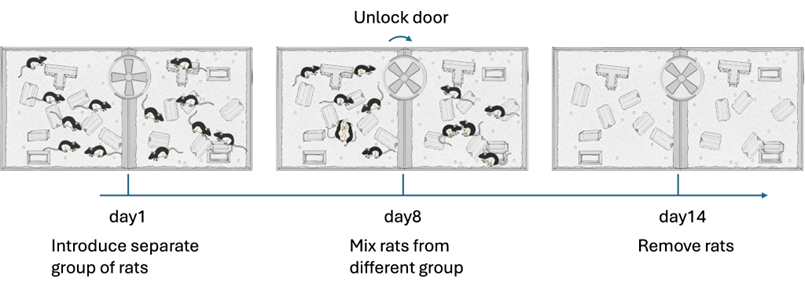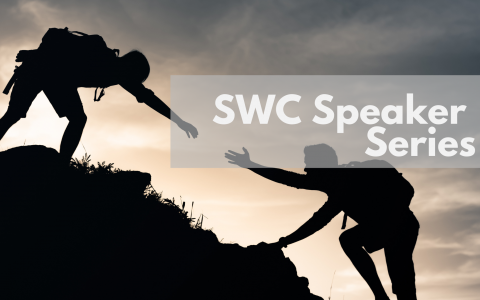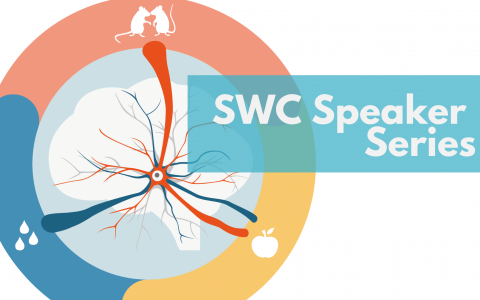
What can rodent societies teach us about our own? Insights from neuroscience
An interview with Dr Gowan Tervo, Janelia Research Campus, conducted by April Cashin-Garbutt
What can rodent societies reveal about the neural basis of social decision-making? In this Q&A, SWC Seminar speaker Dr Gowan Tervo discusses his innovative research using “Rat City” – a modern take on classic ethological paradigms – to explore how animals make decisions in complex social environments.
From an early fascination with moral philosophy to building an indoor zoo-like environment, Dr Tervo shares how his work is uncovering the neural circuits behind group identity, conflict, and cooperation. With potential implications for understanding psychiatric disorders and the foundations of human social behaviour, this research explores a rich and largely uncharted scientific frontier.
What first sparked your interest in societies and decision-making?
We, as humans, are inescapably social. And we almost always live in societies. Our entire lives are patterned by the challenges and opportunities of living in complex, often nested groups: families, friends, etc. While behavioural solutions to these challenges aren't as stereotyped as other animals—as seen in the beautiful and hard-wired social behaviours of eusocial insects—much of our brain's processing must be dedicated to navigating this landscape.
This fundamental aspect of existence is what first drew me to the topic. Initially, I was interested in moral philosophy. I find our human behaviour shocking, inspiring, perplexing and this led me to ask: how and why do people make social decisions based on their experiences and social context? I wanted to understand the underlying neural mechanisms of these social decisions, and how evolution might have shaped the circuits that support these choices.
More pragmatically, I’m interested in how decisions are made under naturalistic conditions because I believe this may be a direct route to answering these questions, despite the power and continued importance of constrained lab environments.
While highly controlled tasks offer experimental precision, they often fail to predict real-world behaviour. This disconnect is especially evident in fields like behavioural economics and it is likely also the case of rodent social behaviour.
How have you set up “Rat City” to study decision-making in societal contexts?
Our indoor zoo-like environment for rats isn’t a novel paradigm – it builds on classic ethological studies, like those by John Calhoun in the US in the mid-20th century and classic work by the Blanchards in what they called a Visible Burrow System. I drew inspiration from these foundational studies to create our indoor zoo-like environment using modern tools.
The idea was to create an environment where we could study different domain-specific and potentially domain-general cognitive capacities of rats with an initial focus on social behaviours and to reduce these cognitive capacities to their neural circuit bases. To do this, we have integrated state-of-the-art behavioural measurements with weeks-long electrophysiology. And our aim is to advance both the behavioural and physiology measurements to allow us to comprehensively capture what each rat is doing and their neural and hormonal responses.
In the long run, we imagine this will result in datasets that capture the societal object with days, weeks and maybe even months of behavioural data simultaneously with physiology data that may permit us to dig into the mechanistic bases of behaviour at the natural time scales in naturalistic environments.
What kinds of group identity and behaviours are you investigating?
Our current goal is to understand what types of social behaviours - broadly - are influenced by group membership. We defined groups based on familiarity and relatedness, as well as giving the animals the opportunity to form territories. This mirrors how rats naturally live - with their kin in extended burrow systems.
A major open question in neuroscience and one that is central to human societies is how animals organise themselves into groups and how group behaviour influences individuals’ social decisions. There are preliminary arguments about how the brain may represent group identity and use these representations to bias decisions, but, in my mind the questions about group-dependent behaviour remain almost entirely unanswered.
Although we are excited by our current results, in the future we aim to target specific circuits that we anticipate will remove animals’ ability to gate their behaviour based upon in-group, out-group identification.
Can you please give an overview of the group merger experiment? How did you track and annotate individual interactions between rats over time?
We introduced two groups of rats, each consisting of six individuals, on separate sides of our indoor zoo-like environment, which was separated into two sides with a large wall. The two sides were connected by a door, which was initially kept closed. We permitted each group to establish territories for seven days. After this, we opened the connecting door to allow interaction between these two groups for another seven days. Using the behavioural annotation of conflict events, we characterise the formation of a new social hierarchy that emerges from the fusion of these two groups.

What have been your key findings so far?
We have found that rats will target their aggressive behaviour dependent on the individual and group identities of their potential targets. Secondly, we have found that this aggression is dependent on the history that individual animals have with another specific animal rather than on the social rank of an animal or other aggressive behaviours in the group. We were surprised to observe this group-dependent and directed aggression and we are currently seeking to understand how the frontal cortex supports this target aggression.
You also used agent-based simulations to model societal conflict – what further insights did these simulations provide?
We’re exploring whether individuals' interactions can predict the time course of conflict to understand if we can predict the time course and dynamics of conflict at the societal level from specific observed behaviours. We’re excited about this, because we believe that we have an opportunity to use our longitudinal behavioural measurements to connect the rules of individual decision-making with those emergent conflict dynamics and social hierarchies.
What do you hope will be the main implications of this research both for neuroscience and human society?
Although I am committed to asking basic scientific questions, in the long term, I’m interested in whether psychiatric disorders can be explained as a consequence of societal dynamics. There is, for example, a famous hypothesis that social demotion and promotion in an established dominance hierarchy cause depression and mania. There’s a long history of studying social stress and its relation to social rank, and I think we’re just scratching the surface of what these models can reveal.

About Gowan Tervo
Gowan Tervo is a Group Leader at the Janelia Research Campus, where he leads a lab focused on the neural bases of rodent social cognition and neuroscience tool development.
The Tervo Lab uses both naturalistic behavioural assays and defined social tasks to investigate the behavioural complexities of social interaction and their mechanistic bases. A current focus is to examine rodent social interactions in societal settings over longitudinal experiments. Within these environments, some key interests are group-dependent behaviour, social hierarchy formation, division of labour, and resource distribution.
The lab also develops tools for systems neuroscience. One current direction involves updating AAV capsids that allow access to different neuronal populations.
Gowan received an undergraduate degree from the University of Oxford and then a Ph.D. from Cold Spring Harbor Laboratory, where his research focused on the presynaptic vesicle cycle. Prior to establishing his own group, he worked as a postdoctoral fellow and a Senior Scientist at Janelia.


